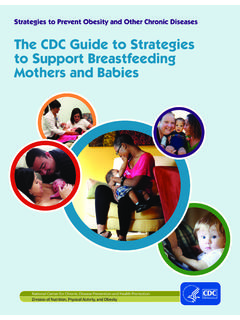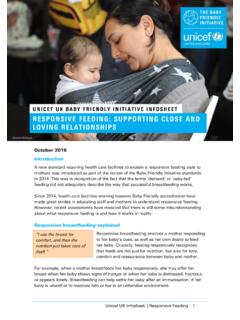Transcription of Mother-to-Mother Support Groups - IYCN
1 Mother-to-Mother Support Groups Fac i l i tato r ' s M a n u a l wi t h D i s c u ss i o n G u i d e Photos: PATH/Evelyn Hockstein March 2011. This document was produced through Support provided by the United States Agency for International Development, under the terms of Cooperative Agreement No. GPO-A-00-06- 00008-00. The opinions herein are those of the author(s) and do not necessarily reflect the views of the United States Agency for International Development. For more information, please contact: The Infant & Young Child Nutrition PATH. (IYCN) Project ACS Plaza, 4th Floor 455 Massachusetts Ave. NW, Suite 1000 Lenana Road Washington, DC 20001 USA Box 76634-00508. Tel: (202) 822-0033 Nairobi, Kenya Fax: (202) 457-1466 Tel: 254-20-3877177. Email: Email: IYCN is implemented by PATH in collaboration with CARE;. The Manoff group ; and University Research Co., LLC. Acknowledgments This manual was originally prepared by PATH in Kenya with funding Support from the United Nations Children's Fund (UNICEF) and technical review and oversight from the Kenya Ministry of Public Health and Sanitation.
2 The Infant & Young Child Nutrition (IYCN). Project updated this manual to reflect the 2010 World Health Organization (WHO). Guidelines on HIV and Infant Feeding. Content for this manual is based on several key Mother-to-Mother Support and infant and young child feeding publications including: Training of Trainers for Mother-to-Mother Support Groups (LINKAGES). Behavior Change Communication for Improved Infant Feeding Training of Trainers for Negotiating Sustainable Behavior Change (LINKAGES). Community-Based breastfeeding Support : A Training Curriculum (Wellstart International). Infant Feeding Counselling: An Integrated Course (WHO/UNICEF). Preparation of Trainer's Course: Mother-to-Mother Support group Methodology, and breastfeeding and Complementary Feeding Basics Instructional Planning Training Package. (CARE/Window of Opportunity Project). We are grateful to these authors for excellent information and activities. Complete citations are available in the reference section of this manual.
3 About PATH. PATH is an international nonprofit organization that creates sustainable, culturally relevant solutions, enabling communities worldwide to break longstanding cycles of poor health. By collaborating with diverse public- and private-sector partners, PATH helps provide appropriate health technologies and vital strategies that change the way people think and act. PATH's work improves global health and well-being. For more information, please visit About the Infant & Young Child Nutrition Project The IYCN Project is the United States Agency for International Development's flagship project on infant and young child nutrition. Begun in 2006, the five-year project aims to improve nutrition for mothers, infants, and young children, and prevent the transmission of HIV to infants and children. IYCN builds on 25 years of the United States Agency for International Development leadership in maternal, infant, and young child nutrition. Our focus is on proven interventions that are effective during pregnancy through the first two years of life.
4 For more information, please visit Mother-to-Mother Support Groups Facilitator's Manual with Discussion Guide i Table of contents Notes to Mother-to-Mother Support group facilitators .. 1. Purpose of this discussion guide .. 1. Mother-to-Mother Support Groups overview .. 1. Understanding Mother-to-Mother Support 2. Support group 3. Facilitator responsibilities .. 5. Facilitation 5. Discussion guide .. 7. First Mother-to-Mother Support group 8. Advantages of exclusive breastfeeding .. 11. Starting breastfeeding immediately .. 14. breastfeeding success .. 16. Lactational amenorrhea method (LAM) .. 19. Expressing breastmilk .. 21. Mother-to-child transmission of HIV .. 26. Infant feeding and HIV .. 30. Feeding babies at 6 months .. 32. Giving other foods after 6 months .. 34. Feeding your child .. 37. Eating during pregnancy and breastfeeding .. 39. Infant feeding beliefs and myths .. 41. Feeding HIV-exposed children from 6 months .. 42. Background 45. Advantages of exclusive breastfeeding .
5 45. Additional information on benefits of breastfeeding .. 46. Start breastfeeding immediately after giving birth .. 46. Positioning and attachment .. 46. Exclusive breastfeeding .. 48. Lactational amenorrhea method (LAM) .. 48. Special situations affecting breastfeeding .. 54. Expressing breastmilk .. 56. Mother-to-child transmission of HIV .. 58. Infant feeding and HIV .. 61. Feeding babies at 6 months .. 62. Complementary feeding .. 63. Preparing foods 64. Helping children to eat .. 64. Feeding children of HIV-positive mothers from 6 months of age .. 65. Planning and reporting tools .. 68. References .. 70. Mother-to-Mother Support Groups Facilitator's Manual with Discussion Guide ii Notes to Mother-to-Mother Support group facilitators Purpose of this discussion guide This guide was developed at the request of Mother-to-Mother Support group facilitators in Western Kenya. It is meant to provide more detailed background information on possible Support group topics for facilitators to use to prepare for meetings, or to do research if mothers have questions that facilitators do not know the answers to.
6 The sample sessions in this guide are not meant to be presented as health talks during Support group meetings. Support group meetings are successful when the facilitator raises a topic and then asks questions to prompt discussion among the members. Using this discussion guide as the basis for a lecture would discourage group members from expressing their own ideas and sharing their strategies for implementing optimal infant and young child nutrition practices. The sample sessions can be read beforehand to help a facilitator feel better prepared for her Support group meeting. Mother-to-Mother Support Groups overview Mother-to-Mother Support Groups (MtMSG) are Groups of women, of any age, who come together to learn about and discuss issues of infant and young child nutrition (IYCN). These women also Support each other as they care for children ages 0 5 years. One member of each group will be trained on IYCN, as well as on basic group facilitation techniques. This person will be responsible for engaging group members in discussion about IYCN and providing basic health education in an interactive, participatory manner.
7 To maximize the effectiveness and sustainability of such Groups , mobilization efforts should focus on identifying and recruiting existing community Groups with women members instead of forming entirely new Groups . Groups should be recruited based on their interest in IYCN. and their regular meeting times, as well as their ability to identify one key member who can undergo training on IYCN. Possible Groups for mobilization include: Women's Groups Church Groups Married adolescent Groups breastfeeding Groups Groups for preventing mother-to-child transmission (PMTCT) of HIV. Groups for people living with HIV/AIDS (PLHA). By using Groups of women who already meet on a regular basis, we can tap into sustainable, ongoing mechanisms to spread additional information about IYCN. The women get together for other reasons, but can supplement this work with additional sessions and information on IYCN. If forming a completely new group , it's important that women understand the purpose of these sessions and feel confident they can manage their own group .
8 MtMSG will not be financially sustained in any way. It's a group formed for the purpose of providing Support and sharing information about IYCN. Mother-to-Mother Support Groups Facilitator's Manual with Discussion Guide 1. Understanding Mother-to-Mother Support Groups Feeling Support usually means that we feel as sense of trust, acceptance, self-worth, value, and respect. When we are supported we can share information better, learn new skills, talk about our thoughts and feelings, and feel connected to others. A Support group is formed when people come together with a common interest or life experience. It may be informal or formal, but includes the following: Safe environment Sense of respect Sharing information Availability of practical help Sharing responsibility Acceptance Learning together and from each other Emotional connection A Mother-to-Mother Support group is a meeting where pregnant women and mothers with young children, as well as other people with similar interests, come together in a safe place to exchange ideas, share experiences, give and receive information, and at the same time, offer and receive Support in breastfeeding , child rearing, and women's health.
9 Mother-to-Mother Support group activities can take place within an existing women's Support group . Mother-to-Mother Support Groups have the following characteristics: Groups have up to 15 participants. Members decide how often they meet. Members decide how long their meetings are. Members Support each other through sharing experiences and information. The group is made up of pregnant and lactating women and other interested people Facilitation is by a breastfeeding counselor with experience (with a co-facilitator who has less experience). The group is open, allowing for new members. Members decide on the topics to be discussed. Facilitator responsibilities include: Identifying future participants. Choosing the date, time, and meeting place. Preparing for the topic. Inviting participants to the meeting. Choosing the meeting time and place: Time: It should not interfere with the primary activities of the members (preparation of meals, washing, market days, chores, work schedules, etc.)
10 Accessibility: If it is a home, it should not be more than 15 25 minutes walking distance from the homes of members. If the community is spread out, the health centre, church, or school could be a good alternative. Place: The place should be safe so that members can bring their children. Mother-to-Mother Support Groups Facilitator's Manual with Discussion Guide 2. Preparing for a meeting: Think of who was invited and prepare a topic that would be of interest to them and that they are able to discuss. Prepare questions that will generate a discussion. Think about questions new mothers usually have about their experiences. Review the content so you feel prepared to answer questions. Facilitating the first meeting: At the beginning of the meeting, the facilitator greets and welcomes everyone. She explains the objectives of the meeting. She asks each participant to introduce themselves, tell the others how they feel about being there, what they expect from the group , and to answer a question as an ice breaker.




